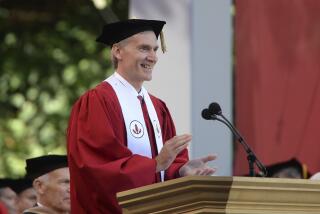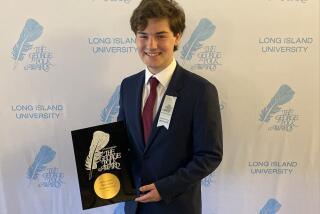Roger Tsien, who was awarded the 2008 Nobel Prize in chemistry, dies at 64
Roger Tsien, the exuberant and resourceful UC San Diego researcher who shared the 2008 Nobel Prize in chemistry for helping to find a more effective way to peer inside cells and organisms, has died. He was 64.
Tsien passed away Aug. 24 apparently on a bike trail in Eugene, Ore., said UC San Diego Chancellor Pradeep Khosla, who broke the news to the campus community Wednesday. The precise cause of death has yet to be determined.
Tsien, a first-generation American who began to explore chemistry at age 8, was hailed for âilluminatingâ the study of such diseases as cancer and HIV. He teamed with fellow scientists Osamu Shimomura and Martin Chalfie to turn green fluorescent protein, or GFP, which is found in jellyfish, into a research tool.
Khosla recalled the collaboration in a statement: âShimomura identified the crucial jellyfish protein and revealed that it glowed bright green under ultraviolet light. Chalfie showed how it could be used as a biological marker. Combining his deep skills in chemistry and biology, Tsien found ways to make GFP glow more brightly and consistently; then he created a full palette of fluorescent proteins that scientists could use to track different cellular processes at the same time.
âGFPs have become a fundamental fixture in life sciences labs around the world, allowing researchers to look into cells or whole animals, to watch molecules interact in real-time and ask questions once thought impossible.â
After winning the Nobel, Tsien told the San Diego Union-Tribune, âIâve always been attracted to colors. Color helps make the work more interesting and endurable. It helps when things arenât going well. If I had been born colorblind, I probably never would have gone into this.â
The news of Tsienâs death caused mourning across the Torrey Pines Mesa in La Jolla, home to one of the nationâs largest life sciences clusters.
âRoger Tsien was truly one of the most remarkable and inspiring scientists of our time,â said Elizabeth Blackburn, a Nobel laureate and president of the Salk Institute for Biological Studies in La Jolla.
âHe will be sorely missed as a colleague for his revolutionary work and keen mind, and also as a wonderful person. I felt privileged to get to know him over the years.â
Nobel laureate K. Barry Sharpless of the Scripps Research Institute in La Jolla said, âRarely are the smartest people the most creative too, but Roger was both.â
Roger Yonchien Tsien was born in New York City on Feb. 1, 1952. His father, Hsue Chu, was an engineer. His mother, Yi Ying Li, trained as a nurse.
His father found various jobs, but those early years werenât easy. Roger Tsien wrote in his Nobel biography that the family âchose a new housing development in Livingston, N.J., but the developer refused to sell to us, saying that they could not permit Livingston to become a Chinatown, nor could they afford the likelihood that other customers would refuse to buy houses next to a Chinese family.
âMy parents appealed to the governor of New Jersey, Robert Meyner. His office sent a letter to the developers warning them that racial discrimination was illegal.â
Tsien prospered as a student and was awarded first prize in the 1968 Westinghouse Science Talent Search for high school seniors.
âI remember being envious of my fellow finalists, who were much more adult and sophisticated,â Tsien wrote in his bio. âAlso their projects and exhibits seemed much more exciting and explainable than mine. I felt intimidated by the senior judge, Glenn Seaborg, partly because of his commanding height, partly because he was chairman of the U.S. Atomic Energy Commission, partly because of his 1951 Nobel Prize for work in inorganic chemistry.â
Tsien went on to study chemistry and physics at Harvard College and later earned a doctorate in physiology at the University of Cambridge in England. He became a junior professor at UC Berkeley before landing at his permanent home, UC San Diego, in 1989.
âUCSD ... was much younger, roomier, faster-growing and less tradition-bound than Berkeley, which I felt more than compensated for its lesser fame.â Tsien wrote in his bio.
Tsien earned many professional honors, including being elected to the Institute of Medicine and the National Academy of Sciences.
He was also known for sticking hard and fast to the facts of science. This side of his personality surfaced in front of 400 people in 2013 at the Salk when Tsien got into an argument with Nobel laureate James Watson during a public lecture.
Tsien didnât agree with what Watson was saying about oxidants and antioxidants and stood to offer a different perspective. Watson tried to blow him off and dismissively said, âAll you have to do is think clearly and these difficulties vanish.â
Tsien calmly replied by telling the agitated Watson that he could find the real facts of the matter by cracking open a particular book. They traded sour looks before a Salk professor stepped in to restore order.
Tsien made light of the situation as he left the auditorium, telling the Union-Tribune: âYou should take all elderly scientists with a grain of salt â including me.â
Robbins writes for the San Diego Union-Tribune.
Union-Tribune staff writer Bradley J. Fikes contributed to this report.
More to Read
Sign up for Essential California
The most important California stories and recommendations in your inbox every morning.
You may occasionally receive promotional content from the Los Angeles Times.










